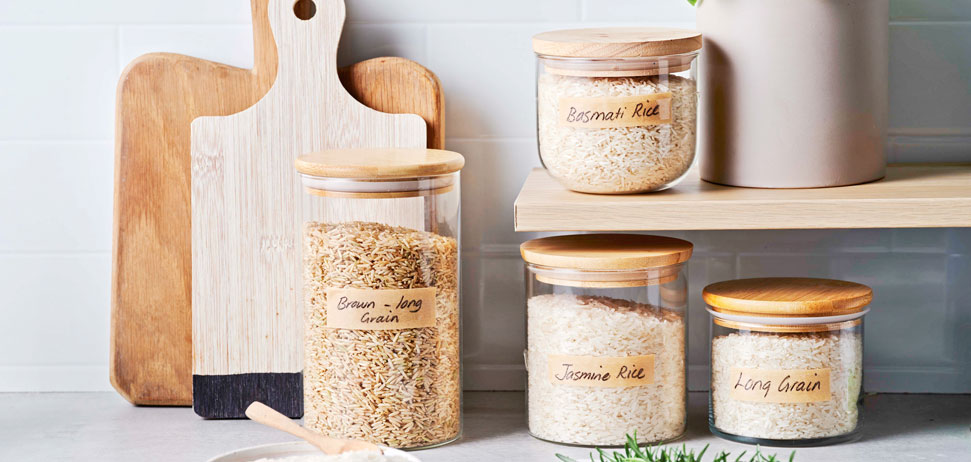When it comes to value staples, rice is hard to beat. Here Coles ambassador Michael Weldon talks us through the rice varieties at Coles.
Your guide to rice

“Each rice variety has its own flavour profile and cooks differently, so it pays to know which one is suited for the dish you’re creating,” says Michael Weldon.
An indispensable ingredient in many cuisines around the world, rice is an everyday pantry staple that can be used in countless ways. With so many varieties now lining the shelves, it’s important to know which ones are best for the dishes you’re cooking. Michael Weldon talks us through some common varieties, so you’ll know which rice is perfect for paella, right for risotto or brilliant for biryani.
Top tip: Start cold
“When cooking any rice variety, start with cold water – this allows the rice to gradually absorb the liquid and cook evenly. Adding rice to boiling water cooks the outside faster than the inside.”
Short grain
Arborio
Famous for making arancini balls and creamy risottos, arborio rice is a very starchy short-grain variety with a slight chew or bite. When cooked slowly over low heat, the starch is extracted from the grains and helps to thicken any liquids to make a sauce. The best risottos are so starchy they spread flat when served in a bowl or on a plate.
Top tip:Toasting arborio rice gives it a wonderful aroma and nutty flavour. When making risotto, cook rice in the pan for 1-2 mins before adding any liquid. This also helps it to keep its shape and not break down when cooking.
Sushi rice
This short-grain variety is the one to use for whipping up sushi and poké bowls. Sushi rice has a slightly sweet but neutral flavour, and a high level of starch. When cooked and seasoned, this is what helps the rice hold together when it’s wrapped around fillings.
Top Tip: It’s important to season sushi rice while it’s still warm so the flavours absorb evenly. Once cooked, set it aside for 5 minutes to cool slightly, then add any seasoning before leaving to cool completely. Always cover the rice with a warm, damp tea towel while it’s cooling.
Medium grain
Medium-grain rice
A versatile ingredient, medium-grain rice sits somewhere between short and long-grain varieties. It soaks up flavours really well, so it’s ideal for serving with saucy dishes like curries or braises, or used as the base for tray bakes and paella. It’s popular in Chinese cooking, and is often the star of fried rice.
Top Tip: Fried rice is best made with firm, day-old rice. Whenever you’re cooking medium-grain rice, cook a little extra to make fried rice the next day.
Brown rice
If you want a feel-good option, brown rice is the one for you. While white rice is processed to remove the bran and germ, brown rice keeps these intact, making it essentially a wholegrain. Brown rice has a nutty flavour and a chewy texture that almost pops when you bite into it. Available in different varieties, such as medium or long grain, it takes longer to cook than white rice but can be used in much the same way. Use it to make wholesome fried rice, or serve it with your favourite curry dish.
Top tip The flavour and texture of brown rice is delicious in salads. To make it easier to toss through leafy greens, rinse it to remove any starch before cooking.
Long grain
Long-grain rice
With a neutral flavour similar to medium-grain rice but with a softer, fluffier texture, long-grain rice is great steamed or used in stuffings. It’s best alongside saucy dishes that need the rice to soak up rich, flavourful gravy or stock such as stroganoff. You can also add it to soups and stews to help them thicken up.
Top tip: To make long-grain rice extra-fluffy, add a tablespoon of olive oil or ghee to the rice when cooking – this helps the grains separate and prevents the rice from clumping.
Basmati
Whether it’s steamed and served with saucy curries or used as the base for biryani, this fragrant rice is an essential part of Indian and Pakistani cuisine. Basmati is a long, thin rice that doubles in size when cooked. It has a rich, nutty and slightly spicy aroma, and is very low in starch. This means the grains stay separate when cooked, giving it a light and fluffy texture.
Top tip: For perfectly cooked basmati rice, soak the grains in cold water for an hour or so before cooking. This allows the grains to absorb some water before being cooked.
Jasmine
A must-have for Thai curries and stir-fries, jasmine rice is traditionally used in South East Asian cuisines. This variety has a subtle floral aroma and a distinctive nutty flavour. It’s commonly served as a side dish with curries, but is also great as a main: think one-pan dishes like vegetable rice or pilaf.
Top tip: When cooking jasmine or basmati rice, use the ratio 1 part rice to 11/2 parts water. Bring to the boil, then simmer for 11 minutes. Set aside to steam for 5 minutes, and you should have perfectly fluffy rice. You can also add coconut flakes or kaffir lime leaves to the cooking liquid for a subtle flavour.

